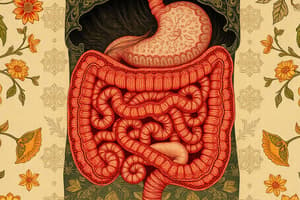Podcast
Questions and Answers
Which level of organization is composed of one major type of cell?
Which level of organization is composed of one major type of cell?
- Organ system level
- Organ level
- Cellular level
- Tissue level (correct)
Which level of organization is composed of varying quantities of tissue types?
Which level of organization is composed of varying quantities of tissue types?
- Organ system level
- Tissue level
- Cellular level
- Organ level (correct)
Which level of organization includes the cardiovascular and respiratory systems?
Which level of organization includes the cardiovascular and respiratory systems?
- Organ level
- Organ system level (correct)
- Cellular level
- Tissue level
Which level of organization includes the nervous system?
Which level of organization includes the nervous system?
Which tissue type performs a discrete set of roles and is responsible for movement?
Which tissue type performs a discrete set of roles and is responsible for movement?
How many different epithelial functions can you list?
How many different epithelial functions can you list?
Which tissue type is responsible for support and protection?
Which tissue type is responsible for support and protection?
Smooth muscle is found in almost every region of the body because it forms an integral part of which of the following?
Smooth muscle is found in almost every region of the body because it forms an integral part of which of the following?
Which of the following is NOT a function of epithelial tissue?
Which of the following is NOT a function of epithelial tissue?
Which type of membrane covers an organ or lines a joint?
Which type of membrane covers an organ or lines a joint?
Which of the following is NOT a function of connective tissue?
Which of the following is NOT a function of connective tissue?
Which of the following is responsible for the structural characteristics of connective tissue?
Which of the following is responsible for the structural characteristics of connective tissue?
Which of the following muscle tissues is responsible for movement in the musculoskeletal system?
Which of the following muscle tissues is responsible for movement in the musculoskeletal system?
Which of the following is true about nervous tissue?
Which of the following is true about nervous tissue?
Which type of cell in the nervous system receives a stimulus from a neuron or a receptor dendrites?
Which type of cell in the nervous system receives a stimulus from a neuron or a receptor dendrites?
What is the primary function of the cardiovascular system?
What is the primary function of the cardiovascular system?
Which organ system is responsible for protection, support, and movement?
Which organ system is responsible for protection, support, and movement?
What is the additional function of the endocrine system?
What is the additional function of the endocrine system?
Which type of cell in the nervous system helps regulate the activities of the autonomic nervous system?
Which type of cell in the nervous system helps regulate the activities of the autonomic nervous system?
What is the primary function of the respiratory system?
What is the primary function of the respiratory system?
Which type of cell in the nervous system cleans up debris and detects microbial invaders/injury?
Which type of cell in the nervous system cleans up debris and detects microbial invaders/injury?
Which of the following is true about disease at the molecular, cellular, or tissue level?
Which of the following is true about disease at the molecular, cellular, or tissue level?
Which of the following physical exam findings may be observed in a patient with anemia?
Which of the following physical exam findings may be observed in a patient with anemia?
Which of the following is a possible physical exam finding in a patient with anemia due to destruction of red blood cells?
Which of the following is a possible physical exam finding in a patient with anemia due to destruction of red blood cells?
What is the cause of the yellow pigment observed in the sclera or skin in a patient with anemia due to destruction of red blood cells?
What is the cause of the yellow pigment observed in the sclera or skin in a patient with anemia due to destruction of red blood cells?
Which level of dysfunction is best understood and explained by physical exam findings in the example of anemia?
Which level of dysfunction is best understood and explained by physical exam findings in the example of anemia?
What are the findings during a physical exam that can help establish a diagnosis or suggest further confirmatory tests?
What are the findings during a physical exam that can help establish a diagnosis or suggest further confirmatory tests?
What is the relationship between multiple organ systems and a cellular → tissue problem?
What is the relationship between multiple organ systems and a cellular → tissue problem?
What is the explanation for an increased heart rate in a patient with anemia?
What is the explanation for an increased heart rate in a patient with anemia?
What is the possible cause of a physiologic murmur in a patient with anemia?
What is the possible cause of a physiologic murmur in a patient with anemia?
Flashcards are hidden until you start studying




